Patrick DeCorla-Souza, Tolling and Pricing Program Manager, FHWA
Lee Munnich, Humphrey Institute, University of Minnesota
Kenneth Buckeye, Minnesota Department of Transportation
John Doan, SRF Consulting
Center for Innovative Finance Support
Federal Highway Administration
Twelfth Part of a Webinar Series on Overcoming the Challenges of Congestion Pricing.
Session 12: Public Acceptability of Congestion Pricing - Webinar
Audio:
- Via Computer - No action needed
- Via Telephone - Mute computer speakers, call 1-866-863-9293 passcode 72773083
Presentations by:
Audience Q&A: addressed after each presentation, please type
your questions into the chat area on the right side of the screen
Closed captioning was available at: http://www.fedrcc.us//Enter.aspx?EventID=1937259&CustomerID=321
Upcoming Webinars:
Visit https://ops.fhwa.dot.gov/congestionpricing/webinars/index.htm
Recordings and Materials from Previous Webinars:
https://www.fhwa.dot.gov/ipd/tolling_and_pricing/resources/webinars/congestion_pricing_2011.aspx
 Part 1: Talking About Congestion Pricing
Part 1: Talking About Congestion Pricing
Probing Citizen Attitudes in the Washington Metropolitan Region
John Swanson
Principal Transportation Planner
Metropolitan Washington Council of Governments
Transportation Planning Board
Webinar on the Public Acceptability of Congestion Pricing
May 3, 2012
The National Capital Region
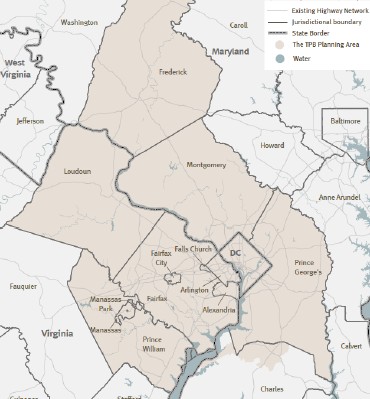
People
- 5.3 million today
- 6.9 million by 2040
- 30% increase
Jobs
- 3.3 million today
- 4.3 million by 2040
- 39% increase
A legacy of progressive planning
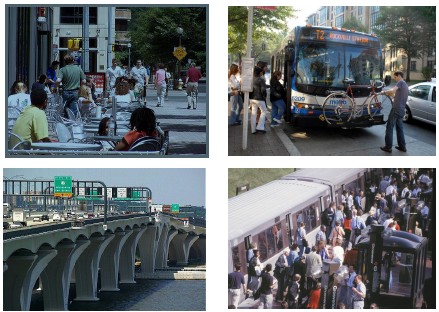
Regional long-range policy
..."Pricing strategies enabled by emerging technology for all modes of travel, including
rates that vary by time of day, type of vehicle, level of emissions, and specific
infrastructure segments used."
- TPB Policy Principles, 2008
Regional discussions, regional analysis
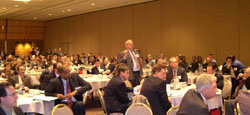
Regional Conference on Value Pricing, 2003
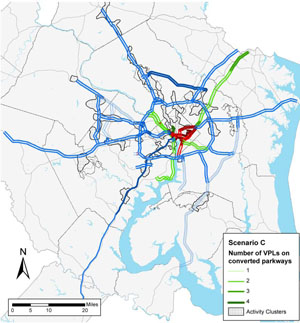
Analysis of a variably priced lane network, 2007
Value pricing projects in the TPB's Constrained Long Range Plan (CLRP)
- Intercounty Connector (ICC)
- Beltway HOT Lanes
- I-95/I-395 HOT Lanes
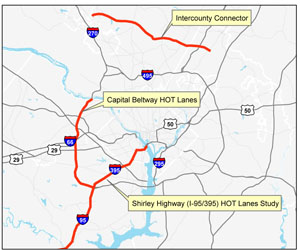
Variably Priced Lanes (VPLs):
- VA: HOT lanes, HOV 3+ free
- DC, MD: Express Toll Lanes (ETL), all pay
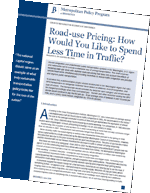
Brookings Institution proposal
- Authorized by Alice Rivlin & Benjamin Orr in 2009
- "proposes replacing state gas taxes with regional road-use pricing"
- "A demonstration project should be launched in the Washington region that
uses GPS transponders to categorize motorists' travel"
Joint Research Project
- Grant awarded in 2011 from the FHWA's Value Pricing Pilot Program
- Partners:
- Transportation Planning Board at MWCOG & Brookings
- Public engagement consultant:
Research Problem
Transportation revenues are decreasing and congestion is increasing.
Congestion pricing is a tool that could partially solve these twin challenges.
But public support for congestion pricing is assumed to be very low.
Research Questions
- As people learn more about congestion pricing, will their attitudes about it
change?
- Upon which factors (costs & benefits) does their acceptance hinge?
- What factors matter to people?
- How strongly do people feel about those factors?
- What factors cause people to change their minds?
Deliberative Forums
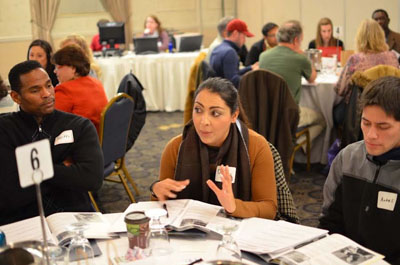
Sampling the region
- Five forums
- October 2011-January 2012
- Each forum 4½ hours
- Approximately 300 paid participants
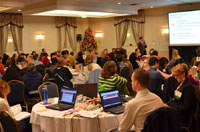
- Cross section of the region
"Why are you here?"
How we explained the forums to participants:
- Congestion pricing is a type of road tolling that could help
solve our funding and congestion problems.
- But, do you believe the benefits are worth the costs?
Let's talk about it...
Information presented on status quo and pricing options
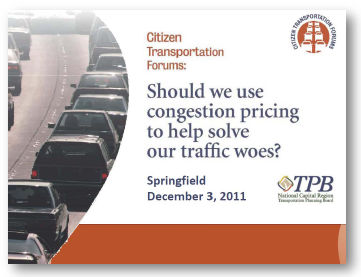
Baseline Information
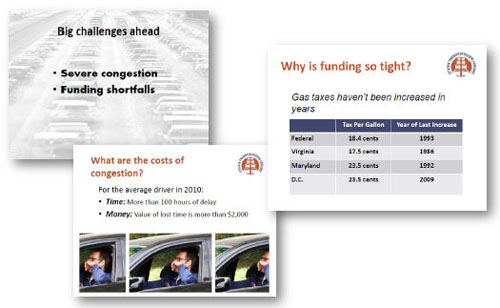
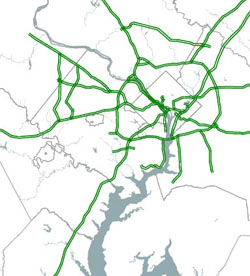
Scenario 1: A Network of Priced
Lanes
What if...
all major highways had at least one tolled lane with free-flowing traffic?
Scenario 2: Pricing on All Streets and Roads
What if...
instead of paying gas taxes drivers paid per-mile fees calculated by GPS?
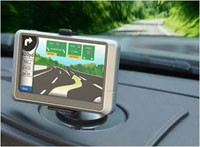
Scenario 3: A Priced Zone
What if...
drivers had to pay to enter central Washington, D.C., Silver Spring, or Tysons Corner?
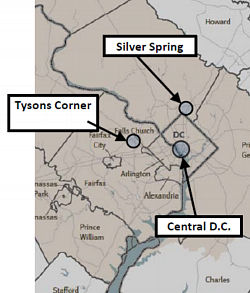
Data Sources
A combination of qualitative and quantitative data:
- Keypad poll questions (including demographics)
- Scribe notes
- Paper surveys
Small groups discuss benefits and costs
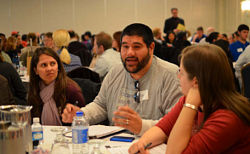
Scribes record discussions
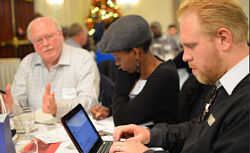
Theme teams summarize comments
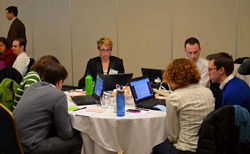
Polling questions throughout the day
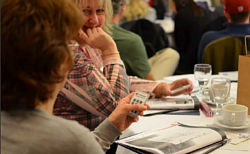
"How to use the keypads"
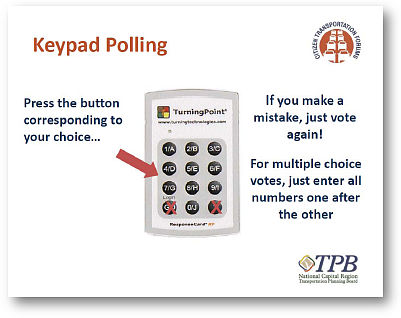
Categories of comment
- Perceptions of the status quo
- General receptivity to congestion pricing overall (reasonableness)
- Perceptions of effectiveness
- Attitudes toward the three scenarios
- The influence of key factors on levels of support
Polling question example: Beginning of the Springfield Forum
Gas taxes should be raised to pay for transportation improvements.
| 7% |
1. Strongly Agree |
| 12% |
2. Agree |
| 14% |
3. Neutral |
| 26% |
4. Disagree |
| 33% |
5. Strongly Disagree |
| 8% |
6. Not Sure |
Polling question example: End of the Springfield Forum
Gas taxes should be raised to pay for transportation improvements
.
| 40% |
1. Strongly Agree |
| 34% |
2. Agree |
| 7% |
3. Neutral |
| 7% |
4. Disagree |
| 10% |
5. Strongly Disagree |
| 3% |
6. Not Sure |
Some poll results
- More people think congestion is a critical problem than think funding is a critical problem.
- At the end of the forums, 54% of participants "strongly agreed" that funding was a critical problem, while 82% "strongly agreed" that congestion was a critical problem.
- From beginning to end of the forum, major increase in support for gas tax increases.
- At the beginning of the forums, 21% of participants thought gas taxes should be raised to pay for transportation improvements. By the end, 57% thought they should be raised.
- Lack of confidence in the public sector's ability to improve transportation even if enough money were available.
- At the beginning of the forums, 39% of participants "disagreed" or "strongly disagreed" with the statement: "If the government had more money so spend on transportation, I am confident we would have a better transportation system.
- Congestion pricing seen as "reasonable" by a sizable number of people.
- At the end of the forum, 45% of participants thought congestion pricing seems like a reasonable way to deal with the region's transportation problems.
- Congestion pricing seen as more effective tool for generating revenue than for reducing congestion.
- As an example: For Scenario 2, 46% said they "strongly" or "somewhat" believed it would be effective in solving our funding problems, while only 29% expressed
similar beliefs in the scenario's effectiveness in reducing congestion.
- Scenario 1 - a priced-lane network on the region's highways - gets the most
support and is seen as the most effective.
- By the end of the forums, 60% of participants said they strongly support or
somewhat support Scenario 1.
- 50% of participants said they believed that Scenario 1 would be "strongly"
or "somewhat" effective at reducing congestion. 60% of participants said
they believed that Scenario 1 would be "strongly" or "somewhat"
effective in solving our funding problems.
- A variable VMT fee (Scenario 2) is a very hard sell.
- By the end of the forums, 86% of participants said they "somewhat opposed"
or "strongly opposed" a variable VMT fee (76% said they "strongly
opposed" it).
- People are evenly divided in their support for a priced zone system (Scenario
3).
- 50% of participants, at the end of the forums, said they would "strongly
support" or "somewhat support" Scenario 3.
The data seem to suggest:
- Doubts about congestion pricing's effectiveness in relieving congestion;
- Assumptions that congestion pricing is primarily for raising money;
- Acceptance -- with education -- that transportation funding is a big problem,
but not that congestion pricing is the solution;
- Gravitation toward options that feel incremental and familiar.
But we're still in the middle of analysis
- More quantitative analysis of poll and survey results
- Review and analysis of scribe notes
- Discuss draft findings in review sessions
- Finalize this summer
Thanks!
For more information:
Part 2: Awareness and Acceptance of Pricing
David L. Dye, P.E., Deputy Secretary
Paula Hammond, P.E., Secretary
Steve Reinmuth, Chief of Staff
Rob Fellows, Toll Planning and Policy Manager

FHWA Webinar
May 3, 2012

Presentation Outline
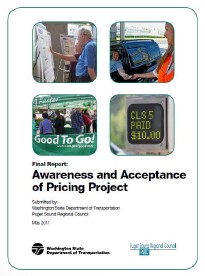 Context - Tolling in Washington
Context - Tolling in Washington- Overview of the Awareness and Acceptance of Pricing (A&AP) project
- Regional Coordination
- Lake Washington Toll Implementation Committee Support
- Pricing Task Force Support
- Additional Surveys and Final Report
- Final Project Report
Current Tolling Projects in Washington

Tacoma Narrows Bridge
- State's first electronic tolling facility opened July 15, 2007

SR 167 HOT Lanes Pilot Project
- State's first high-occupancy toll lanes launched May 3, 2008

SR 520 Evergreen Point Floating Bridge
- Partially funded with major gaps
- Urban Partnership Agreement
- Significant outreach effort
- Tolling began December 2011
Context: Washington Tolling Timeline

Project Activities

Regional Coordination Activities
Products:
- Pricing Acceptance Public Opinion Analysis, July 2007. Includes
analysis of public acceptance research in other cities.
- Pricing Focus Group Research, December 2007.
- Tolling in the Puget Sound Region: Discussion of Commonly
Raised Questions and Issues, February 2008.
- House Transportation Committee presentation, January 2008.
For briefing legislators on the Lake Washington Urban Partnership Agreement, and
on toll choices for the Puget Sound region.
This information supported the Legislature's decision to begin an outreach process
leading to toll authorization the following year.
Findings from National Research
Summarized public opinion research conducted in other areas using pricing.
These elements contributed to public acceptance:
- Educating public about what value pricing is
- Communicating project benefits and coordinating with partners
to ensure consistent messaging
- Providing data and facts to support the benefits statement
- Implementing incrementally so people can experience the benefits
- Emphasizing travel options and choices
- Alternative "free" routes
- Other travel modes
- Different travel times/rates
- Practicing transparent communications about revenue uses
- Coordinating messages between cooperating agencies
Findings from Focus Groups
Focus groups engaged King County drivers and transit riders in congestion
pricing discussions. Findings included:
- Participants' awareness was high of different tolling strategies
- Participants understood HOT lanes more than full-corridor tolling as congestion management strategy
- Lack of understanding regarding tolling all lanes led to skepticism
- Barriers to public acceptance of tolling exist (philosophical
beliefs; government mistrust)
- No standouts for clear terminology to describe "congestion pricing;"
"tolling" was well received, but other modifiers were often added
- Participants support for HOT lanes increased when they learning that low-income
people also support them
- Improved travel options are an incentive to support tolling
- Participants recognized they contribute to congestion, but that didn't transfer
to a sense of responsibility to help alleviate it
"Guiding Principles"
- Tolling should provide measurable user benefits
- Understand effects of tolling on the transportation system, and how to encourage
good system performance
- Understand how toll rate structures affect societal, environmental and land
use decisions over time
- Consider geographic, income and social equity and fairness
- Establish a forum for regional input into tolling
- Ensure effective long-term system-wide operations
- Privacy protections must be adequate
- Different finance approaches have different implications for projects
- Public understanding, awareness and acceptance is needed
- Understand toll rate implications for revenues, operations
and different needs
- Integrate current and future toll collection and enforcement strategies
- Define and clarify how and when toll revenues can be used
Tolling 101 Legislative Topics
- SR 520 and Urban Partnership Update
- Context:
Tolling is one of many traffic management strategies
- Tolling approaches:
Bridges, HOT/express toll lanes, corridor tolling, system tolling
- Tolling objectives:
Funding, traffic management and environmental benefits
- Successes elsewhere:
US HOT lanes, international cordon/area pricing
- Puget Sound region:
Studies, possible projects - near and long term
- Regional coordination efforts:
Guiding principles, research findings, information still needed
Urban Partnership on SR 520
 WSDOT, PSRC and King County entered
into an Urban Partnership agreement with FHWA
WSDOT, PSRC and King County entered
into an Urban Partnership agreement with FHWA
- Early tolling - before new bridge construction
- Variable tolling - tolls vary based on average forecast traffic
volumes
- Technology - installed active traffic management systems
- Transit - new buses and park and ride lot expansion
- Telecommuting - enhance existing commute trip reduction programs
- The Washington State Legislature convened a Toll Implementation Committee
to assess public opinion prior to authorizing SR 520 tolls
- One year outreach program, with report presented the following legislative session
Toll Implementation Committee (TIC)
- Comprised of the Transportation Commission Chair, WSDOT Secretary and Executive
Director of the MPO (PSRC)
- Charged with reporting to the Legislature on:
- Developing and evaluating single and two-bridge toll rate scenarios
- Evaluating potential traffic diversion and mitigation measures
- Evaluating advanced tolling technology and emerging applications
- Exploring opportunities to partner with the business community
- Conferring with mayors and city councils of adjacent jurisdictions
- Conducting public work sessions and open houses.
- Providing a report to the Governor and Legislature by January
2009.
Activities Funded by A&AP Project
 Development of tolling and financing
scenarios
Development of tolling and financing
scenarios- Modeling peer review
- Diversion analysis and mitigation options
- Impact on low income users
- Open road tolling technology assessment
- Outreach:
- to mayors and councils
- to businesses and civic leaders
- open houses
- website
- phone and web surveys
- Report to the Legislature
Toll Scenarios Examined by TIC
- TIC conducted outreach to understand potential impacts of tolling on low-income
communities:
- Widely publicized open houses and website
- Conducted surveys and focus groups - Met with social service agencies
- Research and outreach suggested tolls have greater impact on low-income
families; higher portion of their incomes go toward tolls
- TIC urged consideration of several steps to ease burden; WSDOT's Good To
Go! electronic tolling program includes several:
- Many payment options, including cash and EBT
- Partner with retail outlets for transponder purchase and replenishment
- Increase transit service
- Translate tolling materials into many languages
- Educate service providers
- Consider a transportation allowance for EBT card users
- Examine relationship between toll rates and transit fares
TIC Public Outreach Efforts
 Committee members and staff visited
city councils and business groups
Committee members and staff visited
city councils and business groups- 16,000 visitors to the build520.org website
- 7,800 participants in a web survey gauging opinions on tolling
scenarios
- More than 8,000 written comments to the committee
- More than 700 people attended at least one open house
- Over 20 jurisdictions and stakeholder groups provided input
into the process
- Phone survey of 1,200 randomly selected area residents
Web and Phone Survey Findings
| Respondents support |
Web survey |
Phone Survey |
| Support tolling to help fund new 520 bridge. |
Nearly 2:1 margin (59% to 30%) |
More than 2:1 margin (64% to 30%)
- Non-bridge users highest at 67%
- I-90 users lowest at 60%
|
| Support for tolling 520 increases when respondents learn about electronic tolling
and "no toll booths." |
69% |
73%
- 520 users highest at 78%
- Non-bridge users lowest at 69%
|
| Respondents support variable tolling. |
More than 2:1 margin (65% to 31%) |
More than 2:1 margin (70% to 27%)
- 520 users highest at 73%
- I-90 users lowest at 66%
|
| Respondents support tolling in 2010 if it results in lower tolls and financing costs. |
Nearly 3:1 margin (60% to 23%) |
Less than 2:1 margin (58% to 36%)
- Non-bridge users highest at 59%
- Users of both bridges lowest at 55%
|
| Support goes down for tolling in 2010 if it makes 520 faster, but slows down I-90. |
55% |
51%
- 520 users highest at 56%
- I-90 users lowest at 47%
|
| Support for tolling both bridges goes up (but not among I-90 users) if it makes
speeds go up on both bridges. |
61% |
61%
- 520 users highest at 75%
- I-90 users lowest at 47%
|
| Support for tolling both bridges goes up (but not among I-90 users) if toll rates
are lower than just tolling 520. |
61% |
61%
- 520 users highest at 73%
- I-90 users lowest at 47%
|
| Support for tolling both bridges goes up among I-90 users when they know improvements
will be made to I-90. |
64% |
65%
- 520 users highest at 75%
- I-90 users lowest at 53%
|
Final Report to the Legislature
 The 2009 Washington State Legislature
authorized toll funds to be used for SR 520 construction
The 2009 Washington State Legislature
authorized toll funds to be used for SR 520 construction
Overall findings from outreach efforts:
- Generally, people supported tolling, including early tolling on the SR 520 bridge.
- Most people supported tolling both I-90 and 520, although most
of I-90 users opposed this concept, especially without I-90 improvements.
- Those supporting tolls also support variable tolling to reduce
congestion and improve traffic conditions.
- Electronic tolling was also supported. Most understood that
traffic flow would be better if no toll booths are needed.
Pricing Task Force
- The Puget Sound Regional Council (PSRC) convened a group of local elected
officials and opinion leaders as a Pricing Task Force to:
- Work with other agencies, the public and outside interests
- Pose policy questions regarding roadway pricing
- Provide information on roadway pricing's role in improving
mobility, meeting environmental and economic objectives and providing needed funding
for transportation investment in the region
- Develop a set of objectives, criteria, measures and roadway pricing alternatives to be integrated and evaluated with other transportation strategies
- Make recommendations on a comprehensive set of roadway pricing strategies
that should be included in Transportation 2040
- A&AP provided primarily logistical support and development of meeting materials
Transportation 2040 Alternatives
- Alternative 1: Demand and system management focus and additional
transit services. Limited traditional and tolling revenues.
- Alternative 2: Strategic roadway and transit expansion focus,
including a two lane (HOT) lane network. Sizable new traditional transportation
funding and modest reliance upon tolling.
- Alternative 3: Strategic highway expansion and management balance through user fees/tolling. Modest additional traditional funding for non-highway
uses and tolls to finance highway uses.
- Alternative 4: Integrated mix of investments to improve the
highway efficiency and strategic transit and arterial investments. Limited traditional
transportation funding; significant toll financing for highway investments.
- Alternative 5: Efficiency of the roadway system (freeways and arterials)
and reduced vehicle use to reduce carbon dioxide emissions. Replaces
fuel-based financing with vehicle miles traveled fees and/or congestion tolls on
the arterial and freeway network.

Transportation 2040 Preferred Alternative
- Preferred alternative passed the General Assembly with 98% support
- Incremental tolling expansion between 2010 and 2030
- Routes in gold would be tolled by 2040
Additional Evaluation and Close-out
- Conducted survey of existing toll system users on SR 16 (Tacoma Narrows
Bridge) and the SR 167 HOT lanes
- Conducted public opinion research into potential express toll lane system
on I-5
- Focus groups
- Survey
- These were in advance of any specific project proposal
- Prepared the final project report
Feedback from Existing Toll Users
- Conducted phone survey of existing Tacoma Narrows Bridge (TNB) and SR 167 HOT
lane users
- SR 167 HOT lane users support tolling for both construction and traffic
management; general purpose lane users prioritize construction.
- Of those whose opinions of tolling changed after opening the Tacoma Narrows
Bridge, Good To Go! account holders became more positive towards tolling (70%);
non-account holders were more negative (68%).
- Of those whose opinion changed about tolling after opening SR 167 HOT lanes, 70% of account holders, 47% of non-account holders and 55% of carpool users
became more positive towards tolling.
- About 1/3 of TNB users increased bridge use after tolling began,
but 59% said bridge use decreased due to rate hikes.
- of SR 167 users who were affected by HOT lanes, about half reported less
congestion and greater feeling of safety. Half of potential carpoolers
reported greater likelihood of carpooling.
- Over half of SR 167 users agreed that HOT lanes were beneficial and should be expanded to other Puget Sound highways.
Feedback on I-5 Express Toll Lane Concept
- Focus group findings:
- Unsure express toll lanes would improve traffic
- Did not want to pay to use existing highway
- Some said they might try express toll lanes if in a hurry
- Did not support increasing carpool lane requirements from 2 to 3+ passengers; concerned less people would carpool
- Appealing statements: benefits of reliability, congestion reduction,
and faster travel speeds were more compelling than others
- Survey findings:
- 25% supportive of two-way express toll lanes on I-5; 43% unsupportive
- Almost 1/2 support converting reversible express lanes to toll
lanes
- 1/2 would use at least 1x per month
- 1/3 would use express toll lanes for faster trip
- Over 1/2 would pay up to $2 to increase speed to 45 MPH
- Only 1/3 support increasing HOV requirement from 2 to 3+ people
- Appealing statements: electronic tolling, tolls fund I-5 corridor,
environmental benefits, increased speeds and reliable trips, variable toll rates
based on congestion, all lanes benefit

Final Project Report
- Provides a narrative description of recent tolling developments in the Puget
Sound region
- Provides links to a lot of information developed during the course of the
study
- This was not a research project, and did not develop generalized findings
- these findings are specific to specific projects at a specific point in time
- Download it at:
https://www.wsdot.wa.gov/tolling/planning/aap.htm
Personal Observations
Promote good projects and user value, not just tolls
- SR 520 success has a lot to do with a strong project, a clear
need, and several years of community engagement
Don't start conversation with the public without considering equity and identifying
how revenues will be used
- Early PPP experience
- I-5 express toll lane surveys showed negative response to tolling when use
of revenues are not addressed
Implementation matters
- Is the toll agency credible, responsive, transparent?
- Success and follow-through are essential for future support
Support for tolling is always conditional
- Strong policy support and past successes don't relieve the need to create
strong toll proposals and conduct active outreach all over again
Questions?
Contact:
Rob Fellows
Rob.Fellows@wsdot.wa.gov
or (206) 464-1257
 Part 1: Talking About Congestion Pricing
Part 1: Talking About Congestion Pricing


















![]()
 Context - Tolling in Washington
Context - Tolling in Washington




 WSDOT, PSRC and King County entered
into an Urban Partnership agreement with FHWA
WSDOT, PSRC and King County entered
into an Urban Partnership agreement with FHWA
 Development of tolling and financing
scenarios
Development of tolling and financing
scenarios Committee members and staff visited
city councils and business groups
Committee members and staff visited
city councils and business groups The 2009 Washington State Legislature
authorized toll funds to be used for SR 520 construction
The 2009 Washington State Legislature
authorized toll funds to be used for SR 520 construction
